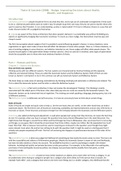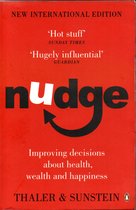Thaler & Sunstein (2008) - Nudge: Improving Decisions about Health,
Wealth, and Happiness
Introduction
Libertarian paternalism: people should be free to do what they like, and to opt out of undesirable arrangements if they want
to do so. Libertarian paternalists want to make it easy for people to go their own way; they do not want to burden those who
want to exercise their freedom. In our understanding, a policy is ‘paternalistic’ if it tries to influence choices in a way that will
make choosers better off, as judged by themselves.
A nudge is any aspect of the choice architecture that alters people’s behavior in a predictable way without forbidding any
options or significantly changing their economic incentives. To count as a mere nudge, the intervention must be easy and
cheap to avoid.
The first misconception about nudges is that it is possible to avoid influencing people’s choices. In many situations, some
organization or agent must make a choice that will affect the behavior of some other people. There is, in those situations, no
way of avoiding nudging in some direction, and whether intended or not, these nudges will affect what people choose. The
second misconception is that paternalism always involves coercion. Since no coercion is involved, some types of paternalism
should be acceptable even to those who most embrace freedom of choice.
Part I – Humans and Econs
Chapter 1 – Biases and Blunders
How we think: two systems
Thinking works with two different systems. The two systems are characterized by intuitive thinking and the opposite,
reflective and rational thinking. These are called the Automatic System and the Reflective System. Both of them are also
known as System 1 and System 2, but in this summary we will use Automatic System and Reflective System.
The brain helps us make sense of seeming contradictions by thinking intuitively and automatic or reflective and rational. The
first is called the Automatic System and the latter is called the Reflective System.
The Automatic System is fast and is instinctive. It does not involve the stereotypical ‘thinking’. This thinking is mostly
associated with the oldest parts of the brain. Also, ideas that pop into our mind are caused by the Automatic System. The
Automatic System can be trained with lots of repetition. This training can entail speaking a language, playing sports, but a lot
of different activities.
The Reflective System is deliberate and self-conscious. It is how we consciously have to think about certain things.
Rules of thumb
Rules of thumb are simple and quick rules to help us. On the one hand, they are useful, on the other hand they can lead to
systematic biases. The first three rules of thumb are anchoring, availability and representativeness and are also referred to as
heuristics or biases. These heuristics and biases emerge from the interplay between the Automatic and the Reflective system.
Anchoring, also called anchoring and adjustment, is used when people start using a fact they do know, to reason the fact they
do not. For example, when you have to answer the question how many citizens Milwaukee has in the state Wisconsin. You
might know that Chicago is around three million and that Chicago lies close to Milwaukee. Also, you know that it is not as big
as Chicago, so you guess that it should be at least lower than three million, maybe one million. But the population lies much
lower than that. That is, because most anchors used in reasoning are irrelevant to the question, even though they might
seem relevant. Even when the anchor has nothing to do with the question itself, it might be used as a starting point but it
actually sets people completely off track. This form of anchoring also happens in questionnaires because of the order of the
questions.
The availability heuristic is when you judge the likelihood of something by how easily the event comes to mind. This has to do
with the accessibility and salience of information people get. Mostly the Automatic System is aware of risks and likelihoods,
but does not take statistics or facts into account. The availability heuristic is used in psychology to explain risk-related
behavior, including both public and private decisions to take precautions. For example, in the aftermath of an earthquake,
purchases of new earthquake insurance policies rise sharply, but purchases decline steadily from that point, as vivid
memories recede.
The representativeness heuristic is based on how similar situations or objects are to each other to fit into a category. It can
be problematic when having to categorize people into a category that seems likely to fit the person that is broader, for
example ‘bank teller’, and a category that seems to be even more fitting, but is a smaller category, thus likelihood that the
1
, person will fall into this category, for example ‘bank teller and feminist’. While the latter might fit more by the description of
a women that is ‘very outspoken, bright, majored in philosophy who is concerned with discrimination issues and social justice
and attended demonstrations before’, the category is way narrower than only one of the two aspects in ‘being a bank teller
and feminist’. Thus, it is less likely for two events to occur along than only one of them.
Optimism and overconfidence
Optimism and overconfidence are nudges that make people feel like they are above average in positive situations and have
less chance of risk in dangerous situations.
People also have the tendency to be optimistic and overconfident, known as the ‘above average effect’. For example, 90
percent of drivers think they are above average drivers, but that is statistically impossible. Even when the stakes are high,
people think unrealistically optimistic about their own situation. This unrealistic optimism can explain risk taking, especially
concerning health and life. People underestimate the likelihood they will get fired, develop a drinking problem, have a heart
attack or get a disease. This comes with the danger that people might fail to take preventive steps. But unrealistic optimism
also has a good side: people stay optimistic, even after bad events happen.
Gains and losses
Loss aversion makes people dislike losses, even though some losses can turn into gains in the end. Loss aversion means that
people dislike losses and makes them try to prevent losses. It maintains the desire to stick to current possessions, because
giving up your possessions would mean loss. Loss aversion operates as a kind of cognitive nudge, pressing us not to make
changes, even when changes are very much in our interests.
Status quo bias
The status quo bias entails that people like to stick to their current situation instead of changing something. Think of a
subscription to a magazine that is for free for the first month, but that you have to pay for after that free month. A lot of
people procrastinate the cancellation of subscriptions or forget about it. One of the causes of status quo bias is a lack of
attention. It is a kind of ‘yeah, whatever’ heuristic that makes people stay subscripted to these magazines, but also makes
people stay at the same channel on television for the whole evening. The status quo bias is a combination of loss aversion
and the ‘yeah, whatever/mindless choosing’ heuristic. This works the same for default options. That is why default options
are so powerful in consumerism.
Framing
Framing is the way statements are stated. This can be done in a positive or negative way, or so to say, a loss or a gain
perspective. Choices depend, in part, on the way which problems are stated. Framing works because people tend to be
somewhat mindless, passive decision makers. Their Reflective system does not do the work that would be required to check
and see whether reframing the questions would produce a different answer. This implies that frames are powerful nudges.
Chapter 2 – Resisting Temptation
Temptation
Most people realize that temptations exists, and they take steps to overcome it. Self-control issues arise because we
underestimate the effect of arousal. This is called the hot-cold empathy gap. When in a cold state, we do not appreciate how
much our desires and our behavior will be altered when we are ‘under the influence’ of arousal. As a result, our behavior
reflects a certain naïveté about the effects that context can have on choice.
Mindless choosing
In many situations, people put themselves into an ‘automatic pilot’ mode, in which they are not actively paying attention to
the task at hand. Many of us simply eat whatever is put in front of us. When self-control problems and mindless choosing are
combined, the result is a series of bad outcomes for real people.
Mental accounting
Internal control systems are also known as mental accounting. Mental accounting is the system (sometimes implicit) that
households use to evaluate, regulate, and process their home budget. For example, twenty dollars in the rent jar can buy just
as much food as the same amount in the food jar. But households adopt mental accounting schemes that violate fungibility
for the same reasons that organizations do: to control spending. Anyone who has ever worked in an organization has
experienced the frustration of not being able to make an important purchase because the relevant account is already
depleted. Keeping the money in separate accounts is just a self-control strategy. Using mental accounts can be valuable. If we
want to encourage savings, it will be important to direct the increased savings into a mental (or real) account where spending
it will not be a too big temptation.
2






